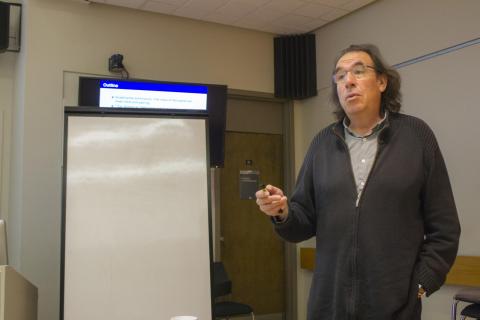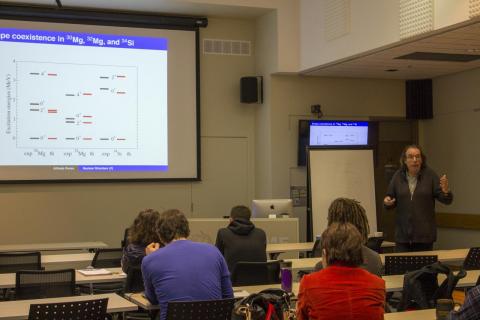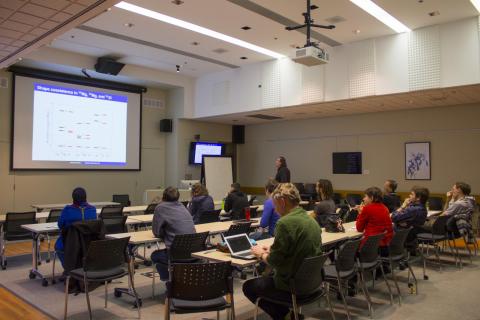


Over September and October, Alfredo Poves captivated over 30 TRIUMF physicists with his master class, Nuclear Structure: A Shell Model Primer. Alfredo hosted the seminar series as part of his sabbatical visit at TRIUMF. This graduate lecture series was aimed at experimental physics, but many theorists attended and benefitted from this series. A brilliant researcher and captivating teacher, Alfredo captured his audience and made his research accessible. He even used political analogies in illustrating the nucleus: “Nuclear structure is the result of a continuous competition between the conservative spherical mean field and the progressive quadrupole - quadrupole interaction.”
The shell model is a successful model that explains an enormous variety of experimental observations in the range of medium-mass nuclei. This model is significant, because it was one of the first successful theories to explain the properties of protons and neutrons in the nucleus, and how they move and interact. The nuclear shell model organizes protons and neutrons by energy levels to find the states where the nucleus is most stable.
Imagine these energy levels are like egg cartons, except, instead of a dozen eggs filling the carton; the cartons have 2, 8, 20, 28, 50, 82 or 126 slots. A full carton means the nucleus is most stable and secure. In nuclear structure, these are referred to as a magic numbers.
Dieter Frekers, a long-time friend and colleague of Alfredo Poves, also studies nuclear structure. Dieter explained how Alfredo changed the picture of the shell model giving it an entirely new and modern appearance, starting with a novel formalism and implementing this into sophisticated computational methods. About 25 years ago, the shell model was limited to the description of light nuclei with less than 20 neutrons or protons. Alfredo built on computational methods and invented new, more sophisticated models that helped to quickly and accurately expand the shell model to a much larger section of the nuclear chart, in particular to its exotic, very neutron rich side.
While he is teaching a well-established model, Alfredo makes the class his own with his point of view and subtle humour. “This lecture series was special. Alfredo has the ability to explain extremely complex matters in simple and understandable ways because he knows every detail about it,” said Dieter.
Alfredo extended the formalism to a variety of nuclear structure effects to explain nuclear structure as a whole. For example, deformed nuclei. “Magic numbers are very vulnerable. We used to think they were a pillar in nuclear structure, but even the doubly magic nucleus of Ca40, which has a spherical ground state, presents deformed and super-deformed states in its spectrum. Hence, we should talk about magic states (typically the ground state), rather than magic nuclei," Alfredo said.
On Halloween Day, Alfredo returned home to Madrid, Spain with his wife, Maria Jesus, having completed his sabbatical. His goal was to increase collaboration between TRIUMF’s theory department and his group in Madrid: “The theoretical physics we do in Madrid is complementary to the theory group here. During my time at TRIUMF, I have discussed with many people, made some contributions to experiments and even written work that will be published. I am eager to come back to TRIUMF someday.”
Alfredo’s visit to TRIUMF has been a magical time of collaboration that benefitted the physics community both in Spain and Canada.
By Kyla Shauer, Communications Assistant and Sonia Bacca, Research scientist in the Theory department
